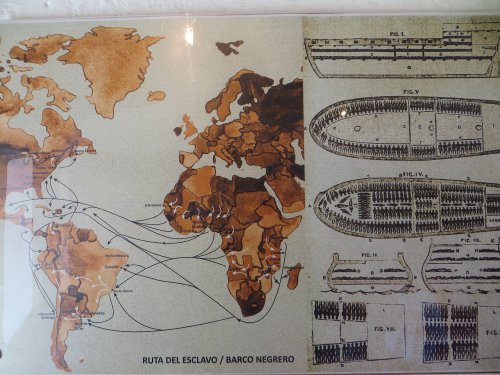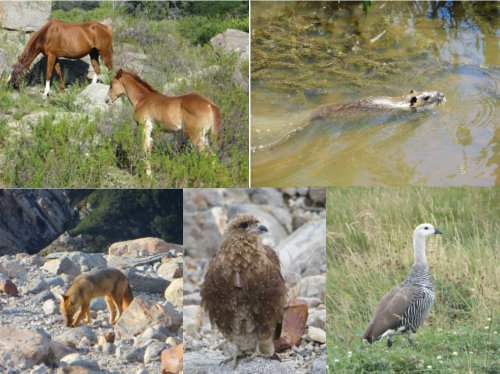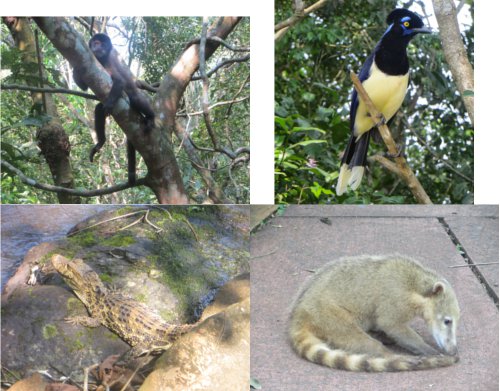Best of Argentina
We visited Argentina for a total of 41 days in three different periods of time. Our first landing in South America was in Buenos Aires on the evening of December 29, 2014, on a flight coming from Casa Blanca, Morocco. During our first time in Argentina, we welcomed the New Year and stayed 7 days before heading on a ferry to Uruguay. We reentered the country by bus on January 19, 2015 through the border crossing between Paysandu, Uruguay and Colon, Argentina. We spent 33 more days traveling the territory. This time around we visited Colon, Rosario, Cordoba, Mendoza, Bariloche, El Chalten, El Calafate, and Ushuaia. The last time we entered the country we crossed the Brazilian border for a day to visit the Iguazu Waterfalls. We spent 103.5 hours traveling by bus while crossing the extensive lands of this country. Everywhere we went we felt welcomed and happy. Our time in this nation allowed us to challenge the negative stereotype commonly spread throughout Latin America that labels Argentinians as arrogant and egocentric. This is a country where everyone, including men, kisses each other in the cheek to say hello and goodbye. We had a very positive experience with the locals we interacted with: they all seem kind, helpful, patient, talkative, and friendly. After our experience, we believe this negative and mistaken image has been wrongly inherited from what the world sees from famous soccer players, such as the famous Maradona, or other few characters that could never represent or do justice to how diverse, conscious, intelligent, and fun Argentinians truly are.
Argentina is a multicultural country with a public system of education and health accessible to everyone. It is a progressive country where gay marriage and marijuana is legal. This is also a country where going to the psychologist or the psychoanalyst for psychotherapy is widely done and accepted, the stigma of seeking mental health services does not seem to exist. Many immigrants from other Latin American countries and other latitudes have planted their roots in this land. The country itself is huge, full of resources, and wealth. Like many Argentinians say “despite all the corrupt politicians and governmental miss fortunes, the country is so rich that they have not been able to completely bankrupt it.” The history of Argentina, like most Latin American countries, is sad, long, and full of freedom struggles which include, not only the battle against the Spanish colonization, but a very dark and tragic period of military dictatorship.

Since the beginning of the colonization, in the 16th century, the original people of the Americas started to develop different forms of resistance, negotiation, and fights against Spanish domination and control. In the 17th century, the collective actions were manifested through numerous protests against the increment of Spanish taxes on products, indigenous labor, and slavery. The viceroyalty of Peru was created by the Emperor Carlos V, establishing Lima as its capital in 1544. The jurisdiction of the viceroyalty of Peru was extensive and covered the actual territories of Peru, Bolivia, Ecuador, Paraguay, Uruguay, Argentina, northern Chile, and southwest Brazil. This amounted to about two-thirds of the entire surface of South America. The liberation campaign of Argentina started in 1810 with the leadership of San Martin. Argentina, Chile, Uruguay, Paraguay, Peru, and Bolivia were liberated by his army. In one of the museums we visited, the National Historic Museum of Buenos Aires, we got to see some objects related to San Martin, including a painting of Simon Bolivar, the liberator of northern South America, who San Martin maintained correspondence and support throughout all their freedom struggles until victory. Argentina obtained its freedom in July 9, 1816.
On March 24, 1976, the Army Forces of Argentina took control of the country and revoked the constitutional government. The Army institutionalized a repressive system of kidnapping, torture, and “vanish” anyone they suspected that was against their regime. 600 centers of clandestine detention were functioning all over the territory. As we learned in the ESMA museum, the main objective of the army was to “install a socioeconomic, political, and cultural model that will benefit the interest of the dominant sectors to extinguish the social achievements of the last century and eliminate the organizations of revolutionary politics in the society.” It has been estimated that during the military dictatorship 30,000 people disappeared in Argentina. Ironically, and regardless of the tragedy that so many were experiencing, Argentina hosted and won the soccer World Cup in 1978. The military regime used the World Cup to mask the human rights violations and crimes they were committing. Soccer was the narcotic that the society celebrated without thinking about the pain. As mentioned earlier, we visited the old Army School of Mechanics (ESMA) where a clandestine center of detention, torture, and extermination functioned between 1976 and 1983. They detained 5000 people that were kidnapped in this center and only 200 survived. During the military dictatorship, more than 400 babies were taken away and, in most cases, their mothers killed during illegal detention. Since 1977, the group of grandmothers, Las Abuelas de Plaza de Mayo, have been fighting to find their disappeared grandchildren and make justice. Thanks to them 116 grandkids have recovered their true identities and because of advances in science, which include the use of genetic testing and forensic anthropology, the group of mothers and grandmothers of Las Madres y Abuelas de Plaza de Mayo have been able to move forward in identifying their disappeared grandchildren and assassinated children. The incident that collapsed the military dictatorship in Argentina was the defeat in the war of sovereignty for the Malvinas Islands or Falklands Islands against Britain in 1982. The loss of the war finally brought down the cruel regime, but Argentinians still grieve the loss of these islands and their people during that dark period in their history. To us, it is unbelievable that the international law still allows Britain to claim ownership over islands that are so far away from their main territory. It is sad to accept that the power of history’s biggest colonizer still dominates the world. 🙁

Currently, the country lives under a polarized political situation. The president, Cristina Kirchner, is both loved and hated by many. Her social policies have benefited low income families with children and unemployed, although these financial benefits are highly needed, the lack of time frame or limit to them seem to be the main reason of concern of many. Her social policies have been classified by her critics as populist strategies to stay in power and guaranty votes.
In a hurry to protect the economic sector and keep capital inside the country, the government has blocked US dollars and placed limits for citizens in exchanging US dollars, which has created a large black market. Many say progresses have been achieved in the area of national technology development and industry, but a big majority of middle class people we met was discontent on the overall policies created by the government. Allegations of vice president corruption, the suspected assassination of a judge, and the President’s unprofessional manner of addressing pressing issues continue to question the transparency of her government. We spoke to many people that feel that the coming presidential elections at the end of 2015 seem hopeless. Most of them seem pessimistic about the possibility of change in the economic and political situation of Argentina.
Regardless of the painful history and difficult political situation, we were sure to take great memories from all the places we visited. In Buenos Aires, a city of Argentinians and immigrants from all over the world where you can see it all, from rich to poor trying to make a living, we were impressed by the cultural and ethnic diversity. Buenos Aires was a point of reunion for us with many friends and family members we have not seen in a while. We were surprised by the high number of people in the streets and metro trying to make some money by selling products, singing, or playing music. We loved the water canals in the area of El Tigre, within the Buenos Aires province, where the conditions of nature and the warm weather during summer made us feel as if we were back in Vietnam. We enjoyed a night of milonga, their famous tango clubs, and felt very surprised to learn that this music has an African influence, since you can rarely see anyone of African descendant in this country. Until now, we wonder what happened to all the Africans that were brought as slaves into the country. Where are they now? Rosario is a peaceful city of tall buildings bordering the River Parana, where we were able to reunite with old friends. We loved this city where Argentina’s flag, Che Guevara, and Messi were born. From Cordoba, we visited the childhood house and museum of Ernesto ‘Che’ Guevara de la Serna, learning about his story and the impact that traveling had on him, which personally inspired us to keep going! “Be always capable of feeling deep inside any injustice committed against any other person in any part of the world. That is the most beautiful quality of a revolutionary.” (Che Guevara, letter to his children – October 1966)
In all the big cities we got to visit in Argentina we experienced a new trend of small restaurants where vegetarian and international food is sold by weight. We also tasted empanadas everywhere and loved their famous asados, minutas (fast food), and Malbec wine. We were interested to find out that many vehicles in Argentina run with GNC (compressed natural gas) which is less expensive than gasoline. In the cities of Cordoba and Mendoza, we learned about the suffering and slavery committed by the colonizers toward different indigenous groups, such as the Comechingones in Cordoba and Huarpe and Yamana in Tierra del Fuego. The military campaign of General Roca in 1879 promoted taking the land for Argentina through the genocide and disintegration of natives, allowing the expansion of the agro-export economy of meat. The construction of railways also encouraged the European migration which created a new land distribution. To balance the horrific history of pain, we enjoyed a day of cycling and wine tasting in Mendoza, got lost in time contemplating the giant and always moving Perito Moreno glacier, spent time trekking and camping in the natural beauty of Patagonia and Tierra del Fuego, and viewing the thunderous Iguazu Falls from several different angles. Learning about the way of living and the end of the Yamana, one of the native indigenous groups of Tierra del Fuego, really impacted us. If you would like to learn more about our trekking days and experiences in Patagonia and Tierra del Fuego make sure to read our article.
We loved Argentina’s land and their people, and we will go back to this gifted country in a heartbeat. 😉
Below are other great things we enjoyed about Argentina:
Food and Drinks
Dulce de Leche: similar to caramel
Empanadas
Havanna Alfajores: cookies with caramel covert with chocolate
Provoleta Cheese
Chorizo: sausage
Morcilla: pig blood sausage
Entraña: cut of meat
Asado de Tira: cut of meat
Basillo: cut of meat
Malbec Wines
Choripan: hot dog with sausage
Chimichurri: parsley-based sauce
Quilmes Beer
Beef Tongue a la Vinagrette
Schneider Beer
Dorado Fish: river fish
Lentil Stew
Locro: pumpkin stew with corn and various meats
Pilsen Cordoba Beer
Humita: sweet pumpkin, corn soup with cheese
Homemade Pasta with meat sauce
Andes Beer
Bariloche Local Brewed Beer
French Fries with 3 Types of Cheese and Bacon
Smoked Trout
Smoked Warthog
Smoked Venison
Patagonia Beer
Lamb Goulash
Hot Chocolate
Calafate Berries

Favorite Sites and Activities
Starring in Awe at the Giant Perito Moreno Glacier in Glaciers National Park – South
Trekking with Views of Mount Fitz Roy and Cerro Torre in Glaciers National Park – North
Listening, Appreciating, and Feeling the Thunderous Iguazu Waterfalls from Different Angles
Day Hiking in Several Areas of the National Park Nahuel Huapi and Heading Back to Bariloche for a Craft Beer
Biking and Wine Tasting through Maipu, Mendoza
Learning about the Indigenous Group, Yamana, in Ushuaia and Tracing their Steps in Tierra del Fuego National Park
Admiring the Natural Beauty of Cordoba, including Los Chorillos Waterfall and Valle Hermoso
Walking through the Culturally, Naturally, and Infrastructural Diverse Streets of Buenos Aires
Tracing Che Guevara’s First Steps in his Childhood Houses in Rosario and Alta Gracia
People
Ariel: from Argentina, originally met in Tanzania and invited us to stay with him in Buenos Aires. We spent over a week with him, including New Year’s, enjoying his company.
Ana Maria: from Colombia, Gisela’s friend from university that we met up with in Buenos Aires.
Eliana and Marcelo: from Colombia and Argentina, Eliana is Gisela’s childhood friend that we were able to meet up with in Buenos Aires.
Juliet, Isabel, Ronald, and family: from Colombia, Juliet and Isabel are cousins of Gisela’s brother and we were able to meet up with them in Buenos Aires.
Yanina and family: from Argentina, friend of a friend of Gisela’s who showed us around Rosario.
Yolanda: from Colombia, mother of Gisela’s friend that hosted us in Rosario.
Daniel: from Colombia/Argentina, Yolanda’s grandchild.
Noe: from Argentina, Yanina’s friend.
Eduardo: from Argentina, our CouchSurfing host in Cordoba.
Paula and her children (Aaron, Adriel, Luna): from Argentina, a friend of Gisela’s cousin that we were able to get together in Valle Hermoso.
Federico: from Argentina, met at a CouchSurfing event in Cordoba.
Augusto: from Argentina, our CouchSurfing host in Bariloche.
Pilar: from Colombia, was CouchSurfing with Augusto.
Max and Mireya: from France and Argentina, met through CouchSurfing and had dinner in El Calafate.
Animals Viewed
Guanaco
Fox
Condor
Horses
Otters
Many Birds
Monkeys
Coatis
Iguanas
Baby Crocodile
Butterflies


Common Sayings
Medialuna = Croissant
Palta = Avocado
Bondi = Bus
Canilla = Faucet
Pileta = Pool
Pive/a = Boy/Girl
Remera = Shirt
Chango = Cart
Heladera = Refrigerator
Nafta = Gasoline
Factura = Sweet Bread
Poroto = Beans
